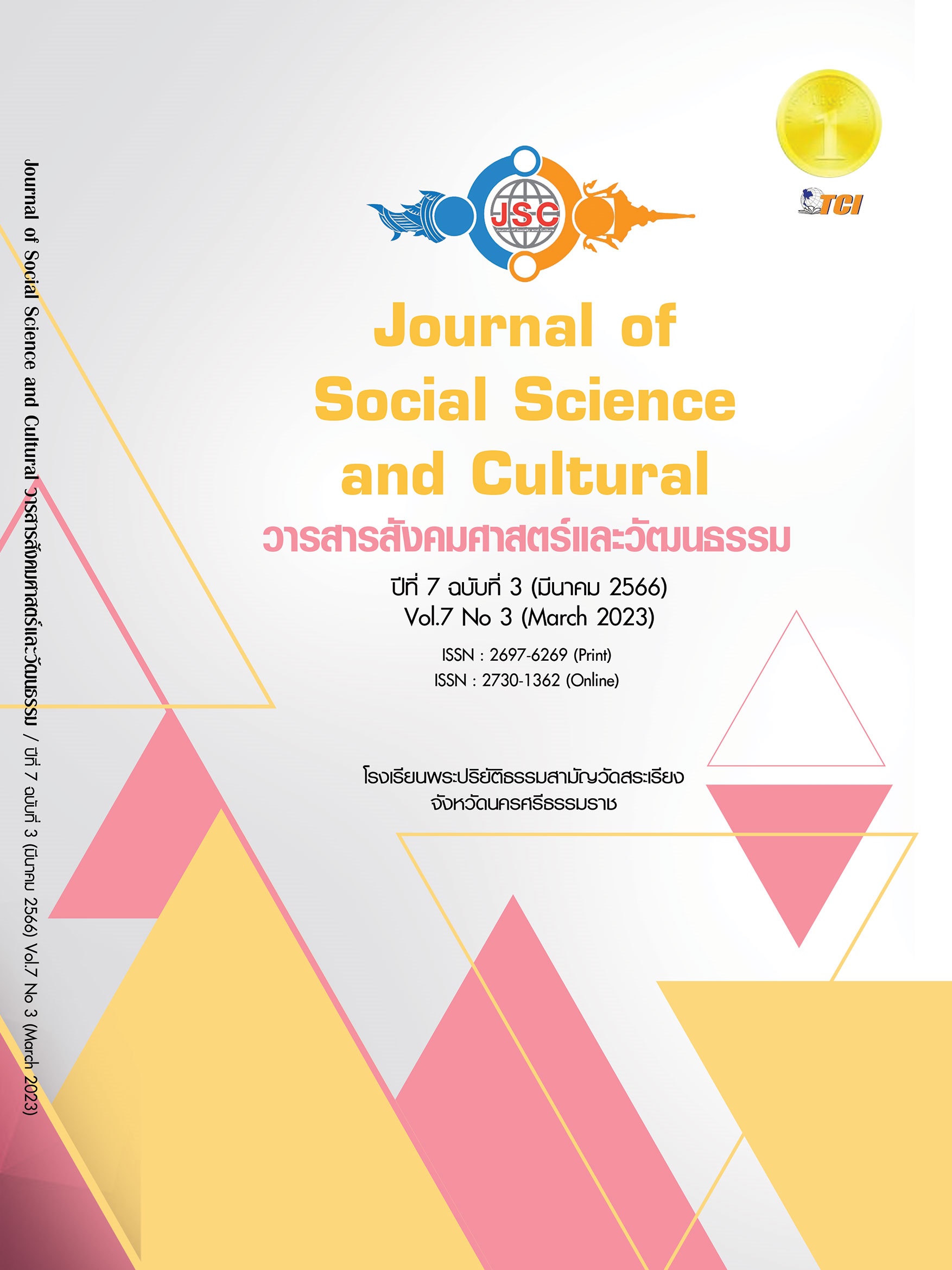การพูดเพื่อสร้างแรงบันดาลใจโดยผู้บริหาร ที่มีต่อความสำเร็จขององค์กร
Main Article Content
บทคัดย่อ
บทความวิชาการนี้มีวัตถุประสงค์เพื่อนำเสนอเกี่ยวกับความหมาย ความสำคัญของแรงบันดาลใจ และความสำคัญของการพูดเพื่อสร้างแรงบันดาลใจโดยผู้บริหารที่มีต่อความสำเร็จขององค์กร การพูดเป็นการสื่อสารของมนุษย์มาแต่สมัยโบราณ คนสมัยก่อนใช้วิธีพูดเพื่อประโยชน์ในการถ่ายทอดความรู้ให้แก่คนรุ่นต่อรุ่น ทางพระพุทธศาสนาเรียกว่า มุขปาฐะ สำหรับการพูดเพื่อสร้างแรงบันดาลใจเป็นการแสดงความรู้สึกหรือแรงกระตุ้นบางอย่างที่เกิดขึ้นกับบุคคล เป็นอารมณ์เชิงบวกที่ประกอบด้วยสามองค์ประกอบ ได้แก่ การปลุกระดม แรงจูงใจ และการอยู่เหนือ ซึ่งแรงบันดาลใจมีความสำคัญเพราะการมีแรงบันดาลใจช่วยให้บุคคลกล้าเปิดรับสิ่งใหม่และมองเห็นเป้าหมายอย่างชัดเจนตามความเป็นจริงและก้าวข้ามความกังวลใจที่เคยเกิดขึ้นและช่วยกระตุ้นพฤติกรรมและกำหนดทิศทางของพฤติกรรมที่มีลักษณะมุ่งมั่นไปด้านหน้าเพื่อไปยังเป้าหมาย ส่วนการพูดเพื่อสร้างแรงบันดาลใจของผู้บริหารองค์กรนั้น เนื่องจากผู้บริหารองค์กรเป็นผู้นำองค์กรที่มีความสำคัญและมีอิทธิพลต่อบุคลากรภายในองค์กร ดังนั้น การพูดสร้างแรงบันดาลใจโดยผู้บริหารองค์กรจึงเป็นกระบวนการสื่อสารภายในองค์กรโดยผู้บริหารเพื่อกระตุ้นให้บุคลากรในองค์กรเกิดแรงบันใจ เกิดความมุ่งมั่นในการปฏิบัติงานและปฏิบัติงานอย่างเต็มความสามารถ จนนำไปสู่ความสำเร็จขององค์กรตามที่กำหนดไว้ โดยที่ตัวชี้วัดความสำเร็จขององค์กรมีหลายมิติ ได้แก่ มิติด้านความเชื่อมั่น และ ความพึงพอใจของผู้มีส่วนได้ส่วนเสียทั้งภายในและภายนอกองค์กร รวมไปถึงตัวชี้วัดความสำเร็จในมิติของการเงินซึ่งวัดผ่านผลประกอบการขององค์กร และความสำเร็จทั้งหมดดังที่กล่าวมาสามารถเกิดขึ้นได้จากการพูดเพื่อสร้างแรงบันดาลใจของผู้บริหารองค์กรนั้น ๆ
Article Details
เอกสารอ้างอิง
กัญจณิพัฐ วงศ์สุเมธรต์. (2549). กระบวนการดำเนินงานโฆษณา. กรุงเทพมหานคร: มหาวิทยาลัยราชภัฏสวนสุนันทา.
ฉวีวรรณ ฉัตรวิไล. (2560). สมรรถนะของผู้บริหารสถานศึกษาที่ส่งผลต่อการดำเนินการตามมาตรฐานเทคโนโลยีสารสนเทศและการสื่อสารเพื่อการศึกษาในสถานศึกษาสังกัดสำนักงานเขตพื้นที่การศึกษามัธยมศึกษา เขต 6 จังหวัดฉะเชิงเทรา. ใน วิทยานิพนธ์ครุศาสตรมหาบัณฑิต สาขาวิชาการบริหารการศึกษา. มหาวิทยาลัยราชภัฎราชนครินทร์.
ไชยวัฒน์ อารีโรจน์. (2558). การพัฒนาแบบฝึกทักษะการพูดรายงานการศึกษาค้นคว้าสำหรับนักเรียนชั้นมัธยมศึกษาปีที่ 3. Veridian E-Journal, Slipakorn University, 8(2), 1824-1841.
ณัฐวดี ศิลากรณ์. (2556). ความสามารถทางการพูดของเด็กปฐมวัยที่ได้รับการจัดกิจกรรมเล่านิทานประกอบหุ่น. ใน วิทยานิพนธ์การศึกษามหาบัณฑิต สาขาวิชาการศึกษาปฐมวัย. มหาวิทยาลัยศรีนครินทรวิโรฒ.
นันทา ทองทวีวัฒนะ. (2565). แนวทางการพัฒนาทักษะและศิลปะการพูดในที่ประชุมชนของนักศึกษามหาวิทยาลัยอัสสัมชัญ. วารสารสหวิทยาการมนุษยศาสตร์และสังคมศาสตร์, 5(3), 912 – 929.
บัณฑิกา จารุมา. (2563). วิธีพัฒนาทักษะการสื่อสารที่มีประสิทธิภาพ. วารสาร มจร มนุษยศาสตร์ปริทรรศน์, 6(1), 413-428.
เมธประจักษ์ เติมกิจขจรสุข. (2563). รูปแบบเทคนิคการพูดสร้างแรงบันดาลใจในการทำงานจิตอาสาโดยพุทธสันติวิธี. วารสารสันติศึกษาปริทรรศน์ มจร , 8(3), 870-881.
รังสาด จันทรวิสูตร์. (2548). การศึกษาความคิดเห็นของผู้บริหารและครูเกี่ยวกับการติดต่อสื่อสารโรงเรียนสังกัดสานักงานเขตพื้นที่การศึกษาสระบุรี. ใน วิทยานิพนธ์ศึกษาศาสตรมหาบัณฑิต สาขาการบริหารการศึกษา. มหาวิทยาลัยเชียงใหม่.
วิฏราธร จิรประวัติ และคณะ. (2558). หลักการโฆษณาและการประชาสัมพันธ์. (พิมพ์ครั้งที่ 8/2558 ปรับปรุงครั้งที่ 2). นนทบุรี: มหาวิทยาลัยสุโขทัยธรรมาธิราช.
สัมมา รธนิธย์. (2554). การวิเคราะห์องค์ประกอบภาวะผู้นำการเปลี่ยนแปลงของผู้บริหารมหาวิทยาลัยราชภัฏที่มีผลต่อประสิทธิผลการบริหารมหาวิทยาลัย. ใน รายงานวิจัย. คณะครุศาสตร์มหาวิทยาลัยราชภัฏสวนสุนันทา.
สุมน อยู่สิน และคณะ. (2548). การพูดและการแสดงสำหรับวิทยุกระจายเสียง. นนทบุรี: สำนักพิมพ์มหาวิทยาลัยสุโขทัยธรรมาธิราช.
สุมิตรา อังวัฒนกุล. (2540). แนวคิดและเทคนิคการสอนภาษาอังกฤษระดับมัธยมศึกษา. กรุงเทพมหานคร: โรงพิมพ์จุฬาลงกรณ์มหาวิทยาลัย.
แสงระวี ดอนแก้วบัว. (2558). ภาษาศาสตร์สำหรับครูสอนภาษาอังกฤษ. กรุงเทพมหานคร: สำนักพิมพ์แห่งจุฬาลงกรณ์มหาวิทยาลัย.
อภิญญารัชต์ จรัชพรวราภัทร์. (2564). บุพปัจจัยของการประสบความสำเร็จของธุรกิจรักษาความปลอดภัย. วารสารสังคมศาสตร์และมานุษยวิทยาเชิงพุทธ, 6(8), 371-385.
อวยชัย ผกามาศ. (2542). วาทการ. (พิมพ์ครั้งที่ 3). ภูเก็ต: สถาบันราชภัฏภูเก็ต.
อิทธิศักดิ์ ศิริจันทร์. (2562). ทักษะการสื่อสารของผู้บริหารสถานศึกษาในศตวรรษที่ 21. วารสารวิชาการมหาวิทยาลัยราชภัฏศรีสะเกษ, 13(1), 136-144.
อินทิรา มีอินทร์เกิด. (2560). แรงบันดาลใจในการทำงานวิชาการ (Inspiration you to work?). กรุงเทพมหานคร: มหาวิทยาลัยธนบุรี.
Alan C. Maltz. (2001). Defining and measuring organizational success: A multi-dimensional framework. Stevens Institute of Technology: ProQuest Dissertations Publishing.
Barrett, D. J. (2006). Leadership Communication: A communication Approach for Senior–Level Managers. Handbook of Business Strategy Emerald Group Publishing, 2006(1), 385-390.
Durbin, L. et al. (1998). Eph signalling is required for segmentation and differentiation of the somites. Genes & Development, 1998(12), 3096-3109.
Hrex. Asia. (2022). Organization Development: OD. Retrieved January 15th, 2023, from https://th.hrnote.asia/orgdevelopment
Indigo Girl. (2020). Executive role The qualities of a good manager - the definition of a manager. Retrieved January 15th, 2023, from https://campus.campus-star.com/jobs/126849.html
Kerlinger, F. N. (1968). Foundations of Behavior Research. Japan: CBS.
Lane, L. K. et al. (2008). Academic Performance of Students with Emotional and Behavioral Disorders Served in a Self-Contained Setting. Journal of Behavioral Education, 17(1), 43-62.
Nunan, D. (1991). Communicative tasks and the language curriculum. TESOL Quarterly, 25(2), 279-291.
Scott, J. (1990). A matter of record: Documentary sources in social research. Cambridge: Polity press.
Scott, J. (2006). Documentary research. London: Sage Publications Ltd.
Shumin, K. (1998). Developing Adult EFL Students’ Speaking Abilities. Retrieved January 10th, 2023, from http/exchanges.state.gov/forum/vols/vol35/ no3/p8.htm
Sobel, A. (2012). Power Questions: Build Relationships, Win New Business, And Influence Others. New York: John Wiley & Sons, Incorporated.
Todd M. Thrash & Andruew J. Elliot. (2003). Inspiration as a Psychological Construct. Journal of Personality and Social Psychology, 84(4), 871-890.
Wartiovaara, M. et al. (2019). The role of inspiration in entrepreneurship: Theory and the future research agenda. Journal of Business Research, 2019(101), 548-554.


